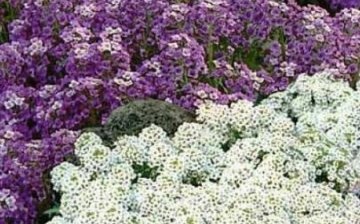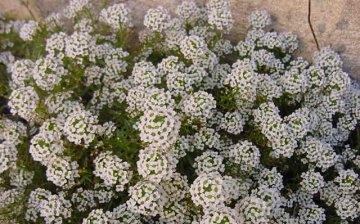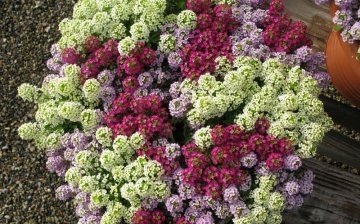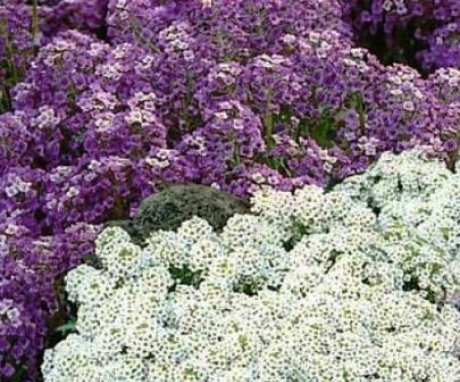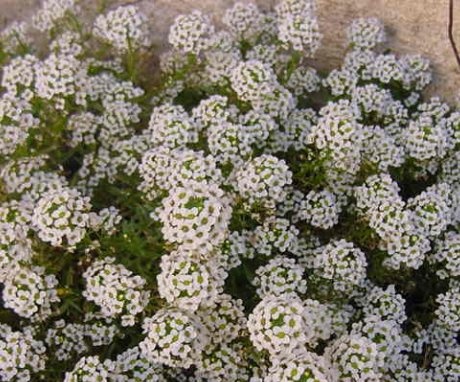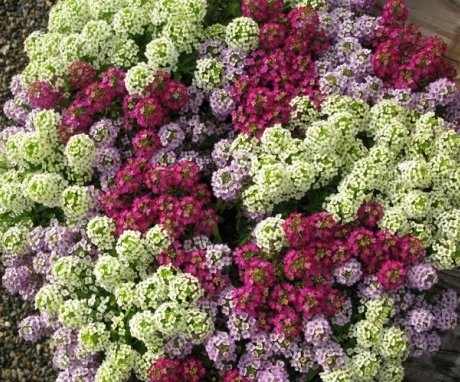Alyssum in the photo - how to decorate paths in the garden
Many plants with short "growth" and beautiful flowers or greenery are used as curbs to decorate paths. Looking at Alyssum in the photo, you understand that this particular plant will be a wonderful decoration for any garden.
Content:
- Types of alissum used in gardening
- Secrets of growing alissum
- The use of alissum in landscape design
- Diseases and pests of alyssum
Types of alissum used in gardening
Alyssum is a herbaceous plant with strong reclining shoots, from which numerous inflorescences depart. Small leaves are grayish-green in color, but they are almost invisible during the flowering of alyssum, since the flowers are collected in very dense racemose inflorescences and create a continuous carpet.
Alyssum is one year old and perennial, the second is more frost-resistant, but the annual has a longer flowering period.
In nature, there are many types of alissum (about 100), and 6 types are common in gardening, such as:
- alissum Gmelin or mountain. Lowest appearance: height from 10 to 20 cm. Light yellow color of flowers; the period of maximum flowering occurs in May – June;
- alyssum sea... Height from 20 to 25 cm. Flowers are white and light purple. Differs in the duration of flowering: from June to frost (withstands - 10 degrees);
- alyssum pyrenean. Height is from 15 to 20 cm. The leaves are silvery oval, and the flowers are white. Blooms only in summer;
- creeping allissum. Height is from 40 to 60 cm. The flowers are bright yellow, and the leaves are oval, collected in a rosette. Blooms in late spring;
- alyssum silvery. It reaches a height of 80 cm. The small leaves are silvery-gray below, and green above. The flowers are lemon yellow. Blooms from May to July;
- alissum rock... Height up to 25 cm. It blooms in bright yellow, the leaves are elongated, grayish-green with a white tint. Blooms in April-May.
As you can see from the above description, different types of alyssum have different flowering periods, which plays an important role in garden design: you can create a continuous flowering pipeline, from early spring to late autumn.
Secrets of growing alissum
Alyssum belongs to unpretentious plants, however, there are several recommendations, adhering to which, you can grow unusually lush and delightfully beautiful flower arrangements:
- Alyssum prefers slightly alkaline, slightly acidic and neutral soils, always well-drained. On swampy soils, the alissum will get wet;
- plants are planted in a well-lit and ventilated place. Alyssum blooms weakly in the shade;
- in spring, last year's stems are cut off from perennial alyssum, and after flowering they are pruned again, due to which it blooms again. In the fall, before wintering, each large branch is cut off, leaving about 3 cm from it;
- alyssum is sensitive to lack of moisture. During flowering, in dry weather, the flowers are watered every evening;
- at first, alissum requires weeding. When the plants gain strength, the fluffy bushes themselves will make sure that the weeds do not grow near them.
Alyssum breeds seeds, dividing the bush and cuttings. Seeds are sown from April to mid-May to a depth of 1.5-2 cm. From the moment of germination, alyssum usually blooms after 40 days.
In perennial alissum, the stems thicken and become longer every year, the bush loses its decorative effect, therefore it is timely replaced with young ones.
The use of alissum in landscape design
Alyssum looks unusually beautiful in group plantings, creating a contrast with both flowering plants and small coniferous plantings. A carpet of bright colors of various colors looks spectacular against the background of a green lawn.
Alyssum is often used to frame various garden paths and recreation areas. Planting can transform even the simplest path into an original garden form. If the path is paved with colored paving slabs, then its beauty will be emphasized by the snow-white alissum bushes.
Plants of yellow color are suitable as a framing of paths made of wood, and will give the garden a feeling of warmth even in cloudy weather. The path from natural stone with live borders of light purple flowers of sea alyssum looks elegant.
Alyssum, varied in shape and color, is an excellent material for the flight of imagination of both landscape design specialists and novice gardeners.
Diseases and pests of alyssum
The contemplation of the beauty of flowers can be overshadowed by diseases such as brown rot, powdery mildew, viral mosaic, jaundice asters.
Pests such as caterpillars, cabbage moth, white turnip and cruciferous fleas do not bypass alyssum.
As soon as the first signs of diseases or pests are noticed, they use means designed to combat them.
Alyssum is valued by most gardeners not only for its ability to become a decorative decoration of the garden, but also to flavor it. A subtle, sweetish scent of blooming alyssum is heard throughout the garden.




